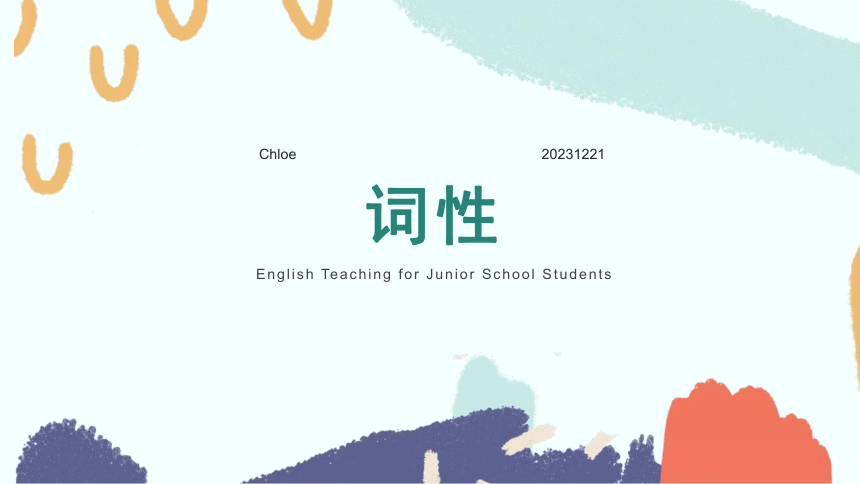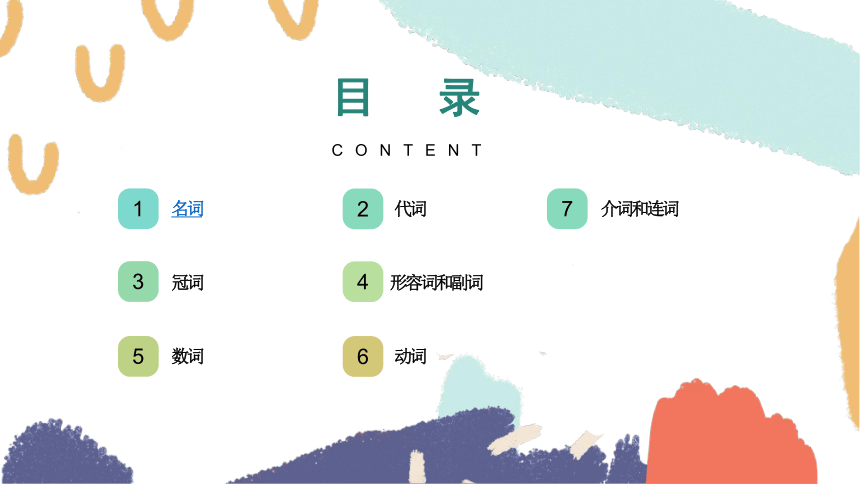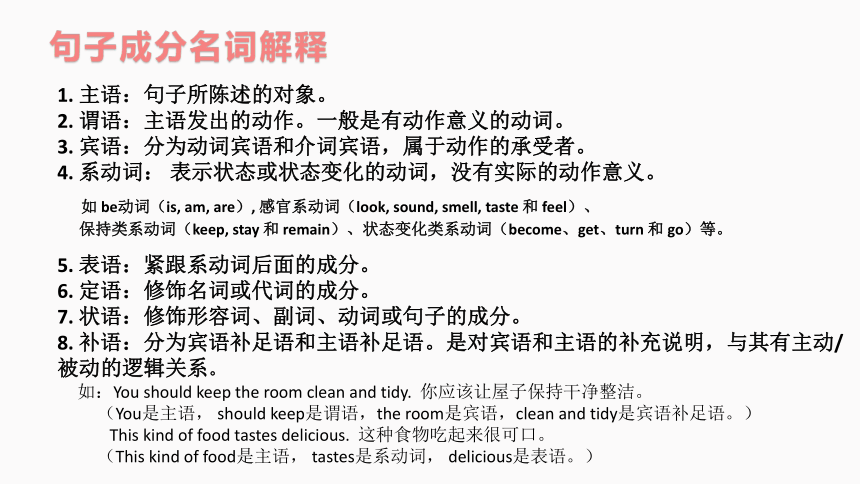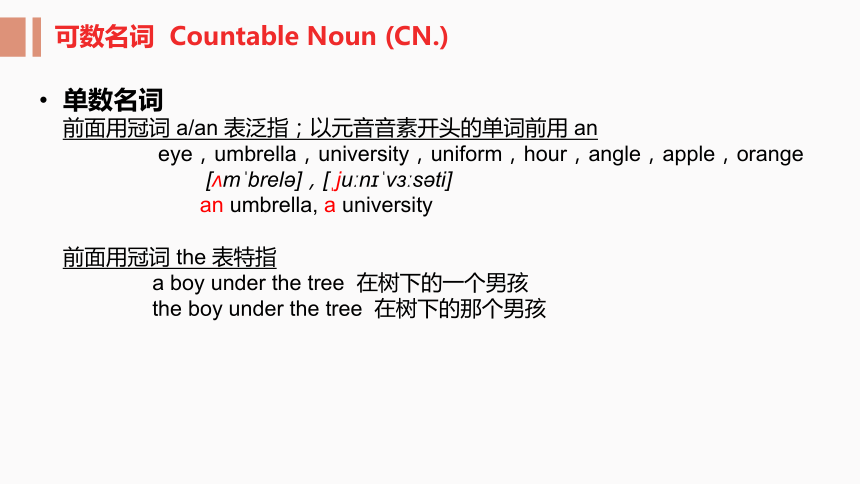通用中考专项复习之名词讲解及简单练习课件(共18张PPT)
文档属性
| 名称 | 通用中考专项复习之名词讲解及简单练习课件(共18张PPT) |  | |
| 格式 | pptx | ||
| 文件大小 | 3.5MB | ||
| 资源类型 | 教案 | ||
| 版本资源 | 通用版 | ||
| 科目 | 英语 | ||
| 更新时间 | 2023-12-22 15:35:33 | ||
图片预览







文档简介
(共18张PPT)
Chloe
20231221
词性
English Teaching for Junior School Students
名词
1
代词
2
冠词
3
形容词和副词
4
数词
5
动词
6
CONTENT
目录
7
介词和连词
1
名词(NOUN ; n.)
概念:表示人、事物、地点或抽象概念的词
名词的功能
名词的功能:名词在句中作主语,宾语,介词宾语,宾语补足语,表语以及名词短语作状语。
1.主语:The bag is in the desk.书包在桌子里边。
2.宾语:I washed my clothes yesterday.昨天我洗了我的衣服。
3.表语:This is a good book.这是一本好书。
4.宾语补助语:We selected him our monitor.我们选他为我们的班长。
5.介词宾语:Mary lives with her parents.玛丽和她的父母亲住在一起。
6.定语:He is a Party member.他是一位党员。
句子成分名词解释
1. 主语:句子所陈述的对象。
2. 谓语:主语发出的动作。一般是有动作意义的动词。
3. 宾语:分为动词宾语和介词宾语,属于动作的承受者。
4. 系动词: 表示状态或状态变化的动词,没有实际的动作意义。
如 be动词(is, am, are), 感官系动词(look, sound, smell, taste 和 feel)、
保持类系动词(keep, stay 和 remain)、状态变化类系动词(become、get、turn 和 go)等。
5. 表语:紧跟系动词后面的成分。
6. 定语:修饰名词或代词的成分。
7. 状语:修饰形容词、副词、动词或句子的成分。
8. 补语:分为宾语补足语和主语补足语。是对宾语和主语的补充说明,与其有主动/被动的逻辑关系。
如:You should keep the room clean and tidy. 你应该让屋子保持干净整洁。
(You是主语, should keep是谓语,the room是宾语,clean and tidy是宾语补足语。)
This kind of food tastes delicious. 这种食物吃起来很可口。
(This kind of food是主语, tastes是系动词, delicious是表语。)
名词的分类
名词
普通名词
专有名词
表示具体的人,事物,地点,团体或机构的专有名称(第一个字母要大写)。 例:China(中国)、Asia(亚洲)、Beijing(北京)、the People's Republic Of China(中华人民共和国)。
专有名词如果含有名词短语,则必须使用定冠词the。如:the Great Wall(长城)。
姓氏名如果采用复数的形式,则表示该姓氏一家人(复数含义)。如:the Greens(格林一家人)。
不可数名词
不能以数目来计算,不可以分成个体的概念、状态、品质、感情或表示物质材料的东西。
可数名词
可数名词是指能以数目来计算,可以分成个体的人或东西,因此它有复数形式。如cup(杯子),cat(猫)等。
可数名词 Countable Noun (CN.)
单数名词
前面用冠词 a/an 表泛指;以元音音素开头的单词前用 an
eye,umbrella,university,uniform,hour,angle,apple,orange
[ m brel ],[ ju n v s ti]
an umbrella, a university
前面用冠词 the 表特指
a boy under the tree 在树下的一个男孩
the boy under the tree 在树下的那个男孩
可数名词 Countable Noun (CN.)
复数名词之规则变化
1.一般情况加 s: book---books mouth---mouths house---houses girl---girls
2.以 s/sh/ch/x 结尾的加 es: class---classes box----boxes match---matches
3.辅音字母 + y 结尾的, 变 y为 i加es: city---cities party---parties
4.以 o 结尾的词 +es的只有以下词: heroes Negroes tomatoes potatoes mangoes
(顺口溜:黑人英雄,左手拿土豆,右手拿番茄,头顶一个大芒果)
以 o 结尾并且词尾有两个元音字母 +s: radios, zoos, bamboos, (pianos, photos)
5.以 f/fe 结尾的,变 f 或 fe 为 v +es: wife---wives knife wolf thief shelf life leave
(妻子持刀去宰狼,小偷吓得发了慌,躲在架后把命保,半片树叶遮目光)
可数名词 Countable Noun (CN.)
复数名词之规则变化读音
1.一般情况加 s: -s 在清辅音后读作/s/ bikes; 在浊辅音和元音后读作/z/ girls
2.以 s/sh/ch/x 结尾的加 es: 读作/iz/ classes
3.辅音字母 + y 结尾的, 变 y为 i加es: 读作/iz/ babies
4.以 o 结尾的词 +es的只有以下词: 读作/z/ heroes
以 o 结尾并且词尾有两个元音字母 +s: 读作/z/ zoos
5.以 f / fe 结尾的,变 f 或 fe 为 v +es: 读作/vz/ leaves
可数名词 Countable Noun (CN.)
复数名词之不规则变化
1、元音发生变化
变a为e: man→men,woman→women 变oo为ee: foot--feet; tooth--teeth
2、单复同形
如:deer,sheep,fish(“鱼肉”不可数;“鱼的条数”单复同形;“鱼的种类”可数名词)
3、集体名词,以单数形式出现,但实为复数
如:people,police等本身就是复数,不能说 a people,a police,但可以说a person,a policeman。
4、常以复数形式出现
如:glasses,clothes;若表达具体数目,要借助数量词 a pair of glasses;two pairs of trousers。
5、表某国人
① 单复同形: Chinese, Japanese
② 词尾加-s: Germans, Americans
③ 变man为men: Englishman--Englishmen; Frenchman--Frenchmen
6、其他形式
child--children; ox--oxen; mouse--mice
特殊用法
另外还有一些名词,其复数形式有时可表特别意思
如:goods货物,waters水域,fishes鱼。
以s结尾,仍为单数的名词
如:maths,politics,physics等学科名词,为不可数名词,是单数;
the United States,the United Nations 应视为单数;
以复数形式出现的书名,剧名,报纸,杂志名,也可视为单数。
不可数名词 Uncountable Noun (UC.)
一般指物质名词、抽象名词、专有名词等,没有复数形式,前面不用冠词 a/an 或数词
表示方法
①可修饰不可数的词或短语
a lot of/lots of; some; much; a little; plenty of; a bit of; a large amoun of
②可以用 数词+量词+of+不可数名词 来修饰
a glass of water
two glasses of water(复数)
名词分类·小结
Who am I
我是谁?
“I’m an apple.”
“I’m a peach.”
“I’m water.”
可数名词表单数概念时
前面要加冠词a/an/one等表“一个”
an 用来形容 元音开头的单词
a 用来形容 辅音开头的单词
不可数名词
前面不加任何冠词
We’re apples.
We’re peaches.
We’re leaves.
We’re water.
【可数名词】1.一般情况加 s
2.以 s/sh/ch/x 结尾的加 es3.辅音字母 + y 结尾的, 变 y为 i加es
4.以 o 结尾的词 +es
5.以 f/fe 结尾的,变 f 或 fe 为 v +es
【不可数名词】可以用 数词+量词+of+不可数名词 来修饰
a glass of water
two glasses of water(复数)
We’re potatoes.
We’re seven glasses of water.
名词的格
-’s 所有格
1. 一般情况下直接加 -’s
2. 以 s 结尾的人或单数名词后加 -’或 -’s
eg. Dickens’s home/Dickens’ home
3. 以 s 或 es 结尾的复数名词后只加 -’
eg. boys’ game
4. 由 and 连接的两个或多个名词,表示共同拥有时,只将最后一个名词变成所有格形式,后面名词用单数;表各自拥有时,每个名词都要变成所有格形式,后面的名词要用复数
eg. Mary and Jack’s house.玛丽和杰克的房子
Mary’s and Jack’s houses. 玛丽的房子和杰克的房子(分别拥有)
of 所有格
1.of所有格一般用于无生命的东西的名词中
eg. a map of the world; the story of a hero
2.用于名词化的词.
eg. the sticks of the blind盲人的拐杖
3.修饰词较多时也可用of所有格.
eg. the very long and graceful tail of cat 猫又长又美的尾巴
4.表示有生命的东西的名词,有时也可以用of所有格
the children of the family那家的孩子们
某些of所有格和's所有格可以互换.
the son of a poor peasant=a poor peasant's son
但有时含义却不相同,请比较下面的例子:
an old woman's story(一个老妇人讲自己的身世)
the story of an old woman(别人讲一个老妇人的身世)
Exercise 1: 名词的数
1. strawberry_____ 2. dictionary____ 3. party____
4. bay____ 5. woman________ 6. month______
7. radio_____ 8. rain_____ 9. bus _______
10. leaf ______ 11. box ______ 12. brush ______
13. milk ______ 14. fish ______ 15. chicken_____
16. photo ______ 17. potato _____ 18. family ______
strawberries
women
dictionaries
months
parties
bays
radios
rain
bus
leaves
boxes
brushes
milk
fish(鱼肉)/fishes(种类)
chicken(鸡肉)
photos
patatoes
families
1. She is very busy every day because many _______(baby) need her help.
2. Our father and __________(mother) room is big.
3. Knowing about ________(children) interests is interesting”.
4.March 8th is __________Day. (woman).
5.I’ll give my English teacher a card for ____________Day. (teacher)
6.It’s only ten __________walk from the station to the hotel. (minute)
7.There are _________(apple)and _______(milk) on the table.
8. This is my _______( sister) computer game.
9. Her ______(watch) are under the bed.
sister’s
watches
babies
mother’s
children’s
Women’s
Teachers’
minutes’
apples
milk
Chloe
20231221
词性
English Teaching for Junior School Students
名词
1
代词
2
冠词
3
形容词和副词
4
数词
5
动词
6
CONTENT
目录
7
介词和连词
1
名词(NOUN ; n.)
概念:表示人、事物、地点或抽象概念的词
名词的功能
名词的功能:名词在句中作主语,宾语,介词宾语,宾语补足语,表语以及名词短语作状语。
1.主语:The bag is in the desk.书包在桌子里边。
2.宾语:I washed my clothes yesterday.昨天我洗了我的衣服。
3.表语:This is a good book.这是一本好书。
4.宾语补助语:We selected him our monitor.我们选他为我们的班长。
5.介词宾语:Mary lives with her parents.玛丽和她的父母亲住在一起。
6.定语:He is a Party member.他是一位党员。
句子成分名词解释
1. 主语:句子所陈述的对象。
2. 谓语:主语发出的动作。一般是有动作意义的动词。
3. 宾语:分为动词宾语和介词宾语,属于动作的承受者。
4. 系动词: 表示状态或状态变化的动词,没有实际的动作意义。
如 be动词(is, am, are), 感官系动词(look, sound, smell, taste 和 feel)、
保持类系动词(keep, stay 和 remain)、状态变化类系动词(become、get、turn 和 go)等。
5. 表语:紧跟系动词后面的成分。
6. 定语:修饰名词或代词的成分。
7. 状语:修饰形容词、副词、动词或句子的成分。
8. 补语:分为宾语补足语和主语补足语。是对宾语和主语的补充说明,与其有主动/被动的逻辑关系。
如:You should keep the room clean and tidy. 你应该让屋子保持干净整洁。
(You是主语, should keep是谓语,the room是宾语,clean and tidy是宾语补足语。)
This kind of food tastes delicious. 这种食物吃起来很可口。
(This kind of food是主语, tastes是系动词, delicious是表语。)
名词的分类
名词
普通名词
专有名词
表示具体的人,事物,地点,团体或机构的专有名称(第一个字母要大写)。 例:China(中国)、Asia(亚洲)、Beijing(北京)、the People's Republic Of China(中华人民共和国)。
专有名词如果含有名词短语,则必须使用定冠词the。如:the Great Wall(长城)。
姓氏名如果采用复数的形式,则表示该姓氏一家人(复数含义)。如:the Greens(格林一家人)。
不可数名词
不能以数目来计算,不可以分成个体的概念、状态、品质、感情或表示物质材料的东西。
可数名词
可数名词是指能以数目来计算,可以分成个体的人或东西,因此它有复数形式。如cup(杯子),cat(猫)等。
可数名词 Countable Noun (CN.)
单数名词
前面用冠词 a/an 表泛指;以元音音素开头的单词前用 an
eye,umbrella,university,uniform,hour,angle,apple,orange
[ m brel ],[ ju n v s ti]
an umbrella, a university
前面用冠词 the 表特指
a boy under the tree 在树下的一个男孩
the boy under the tree 在树下的那个男孩
可数名词 Countable Noun (CN.)
复数名词之规则变化
1.一般情况加 s: book---books mouth---mouths house---houses girl---girls
2.以 s/sh/ch/x 结尾的加 es: class---classes box----boxes match---matches
3.辅音字母 + y 结尾的, 变 y为 i加es: city---cities party---parties
4.以 o 结尾的词 +es的只有以下词: heroes Negroes tomatoes potatoes mangoes
(顺口溜:黑人英雄,左手拿土豆,右手拿番茄,头顶一个大芒果)
以 o 结尾并且词尾有两个元音字母 +s: radios, zoos, bamboos, (pianos, photos)
5.以 f/fe 结尾的,变 f 或 fe 为 v +es: wife---wives knife wolf thief shelf life leave
(妻子持刀去宰狼,小偷吓得发了慌,躲在架后把命保,半片树叶遮目光)
可数名词 Countable Noun (CN.)
复数名词之规则变化读音
1.一般情况加 s: -s 在清辅音后读作/s/ bikes; 在浊辅音和元音后读作/z/ girls
2.以 s/sh/ch/x 结尾的加 es: 读作/iz/ classes
3.辅音字母 + y 结尾的, 变 y为 i加es: 读作/iz/ babies
4.以 o 结尾的词 +es的只有以下词: 读作/z/ heroes
以 o 结尾并且词尾有两个元音字母 +s: 读作/z/ zoos
5.以 f / fe 结尾的,变 f 或 fe 为 v +es: 读作/vz/ leaves
可数名词 Countable Noun (CN.)
复数名词之不规则变化
1、元音发生变化
变a为e: man→men,woman→women 变oo为ee: foot--feet; tooth--teeth
2、单复同形
如:deer,sheep,fish(“鱼肉”不可数;“鱼的条数”单复同形;“鱼的种类”可数名词)
3、集体名词,以单数形式出现,但实为复数
如:people,police等本身就是复数,不能说 a people,a police,但可以说a person,a policeman。
4、常以复数形式出现
如:glasses,clothes;若表达具体数目,要借助数量词 a pair of glasses;two pairs of trousers。
5、表某国人
① 单复同形: Chinese, Japanese
② 词尾加-s: Germans, Americans
③ 变man为men: Englishman--Englishmen; Frenchman--Frenchmen
6、其他形式
child--children; ox--oxen; mouse--mice
特殊用法
另外还有一些名词,其复数形式有时可表特别意思
如:goods货物,waters水域,fishes鱼。
以s结尾,仍为单数的名词
如:maths,politics,physics等学科名词,为不可数名词,是单数;
the United States,the United Nations 应视为单数;
以复数形式出现的书名,剧名,报纸,杂志名,也可视为单数。
不可数名词 Uncountable Noun (UC.)
一般指物质名词、抽象名词、专有名词等,没有复数形式,前面不用冠词 a/an 或数词
表示方法
①可修饰不可数的词或短语
a lot of/lots of; some; much; a little; plenty of; a bit of; a large amoun of
②可以用 数词+量词+of+不可数名词 来修饰
a glass of water
two glasses of water(复数)
名词分类·小结
Who am I
我是谁?
“I’m an apple.”
“I’m a peach.”
“I’m water.”
可数名词表单数概念时
前面要加冠词a/an/one等表“一个”
an 用来形容 元音开头的单词
a 用来形容 辅音开头的单词
不可数名词
前面不加任何冠词
We’re apples.
We’re peaches.
We’re leaves.
We’re water.
【可数名词】1.一般情况加 s
2.以 s/sh/ch/x 结尾的加 es3.辅音字母 + y 结尾的, 变 y为 i加es
4.以 o 结尾的词 +es
5.以 f/fe 结尾的,变 f 或 fe 为 v +es
【不可数名词】可以用 数词+量词+of+不可数名词 来修饰
a glass of water
two glasses of water(复数)
We’re potatoes.
We’re seven glasses of water.
名词的格
-’s 所有格
1. 一般情况下直接加 -’s
2. 以 s 结尾的人或单数名词后加 -’或 -’s
eg. Dickens’s home/Dickens’ home
3. 以 s 或 es 结尾的复数名词后只加 -’
eg. boys’ game
4. 由 and 连接的两个或多个名词,表示共同拥有时,只将最后一个名词变成所有格形式,后面名词用单数;表各自拥有时,每个名词都要变成所有格形式,后面的名词要用复数
eg. Mary and Jack’s house.玛丽和杰克的房子
Mary’s and Jack’s houses. 玛丽的房子和杰克的房子(分别拥有)
of 所有格
1.of所有格一般用于无生命的东西的名词中
eg. a map of the world; the story of a hero
2.用于名词化的词.
eg. the sticks of the blind盲人的拐杖
3.修饰词较多时也可用of所有格.
eg. the very long and graceful tail of cat 猫又长又美的尾巴
4.表示有生命的东西的名词,有时也可以用of所有格
the children of the family那家的孩子们
某些of所有格和's所有格可以互换.
the son of a poor peasant=a poor peasant's son
但有时含义却不相同,请比较下面的例子:
an old woman's story(一个老妇人讲自己的身世)
the story of an old woman(别人讲一个老妇人的身世)
Exercise 1: 名词的数
1. strawberry_____ 2. dictionary____ 3. party____
4. bay____ 5. woman________ 6. month______
7. radio_____ 8. rain_____ 9. bus _______
10. leaf ______ 11. box ______ 12. brush ______
13. milk ______ 14. fish ______ 15. chicken_____
16. photo ______ 17. potato _____ 18. family ______
strawberries
women
dictionaries
months
parties
bays
radios
rain
bus
leaves
boxes
brushes
milk
fish(鱼肉)/fishes(种类)
chicken(鸡肉)
photos
patatoes
families
1. She is very busy every day because many _______(baby) need her help.
2. Our father and __________(mother) room is big.
3. Knowing about ________(children) interests is interesting”.
4.March 8th is __________Day. (woman).
5.I’ll give my English teacher a card for ____________Day. (teacher)
6.It’s only ten __________walk from the station to the hotel. (minute)
7.There are _________(apple)and _______(milk) on the table.
8. This is my _______( sister) computer game.
9. Her ______(watch) are under the bed.
sister’s
watches
babies
mother’s
children’s
Women’s
Teachers’
minutes’
apples
milk
同课章节目录
- 词法
- 名词
- 动词和动词短语
- 动词语态
- 动词时态
- 助动词和情态动词
- 非谓语动词
- 冠词
- 代词
- 数词和量词
- 形容词副词及其比较等级
- 介词和介词短语
- 连词和感叹词
- 构词法
- 相似、相近词比较
- 句法
- 陈述句
- 一般疑问句和否定疑问句
- 特殊疑问句及选择疑问句
- 反意疑问句
- 存在句(There be句型)
- 宾语从句
- 定语从句
- 状语从句
- 主谓一致问题
- 简单句
- 并列句
- 复合句
- 主谓一致
- 主、表语从句
- 名词性从句
- 直接引语和间接引语
- 虚拟语气
- 感叹句
- 强调句
- 倒装句
- 祈使句
- 句子的成分
- 句子的分类
- 题型专区
- 单项选择部分
- 易错题
- 完形填空
- 阅读理解
- 词汇练习
- 听说训练
- 句型转换
- 补全对话
- 短文改错
- 翻译
- 书面表达
- 任务型阅读
- 语法填空
- 其他资料
